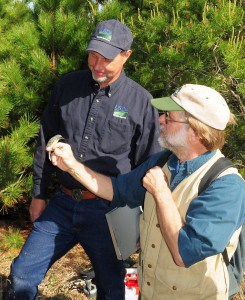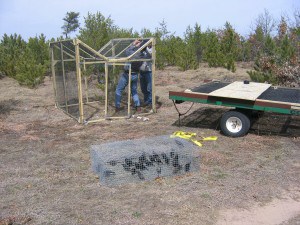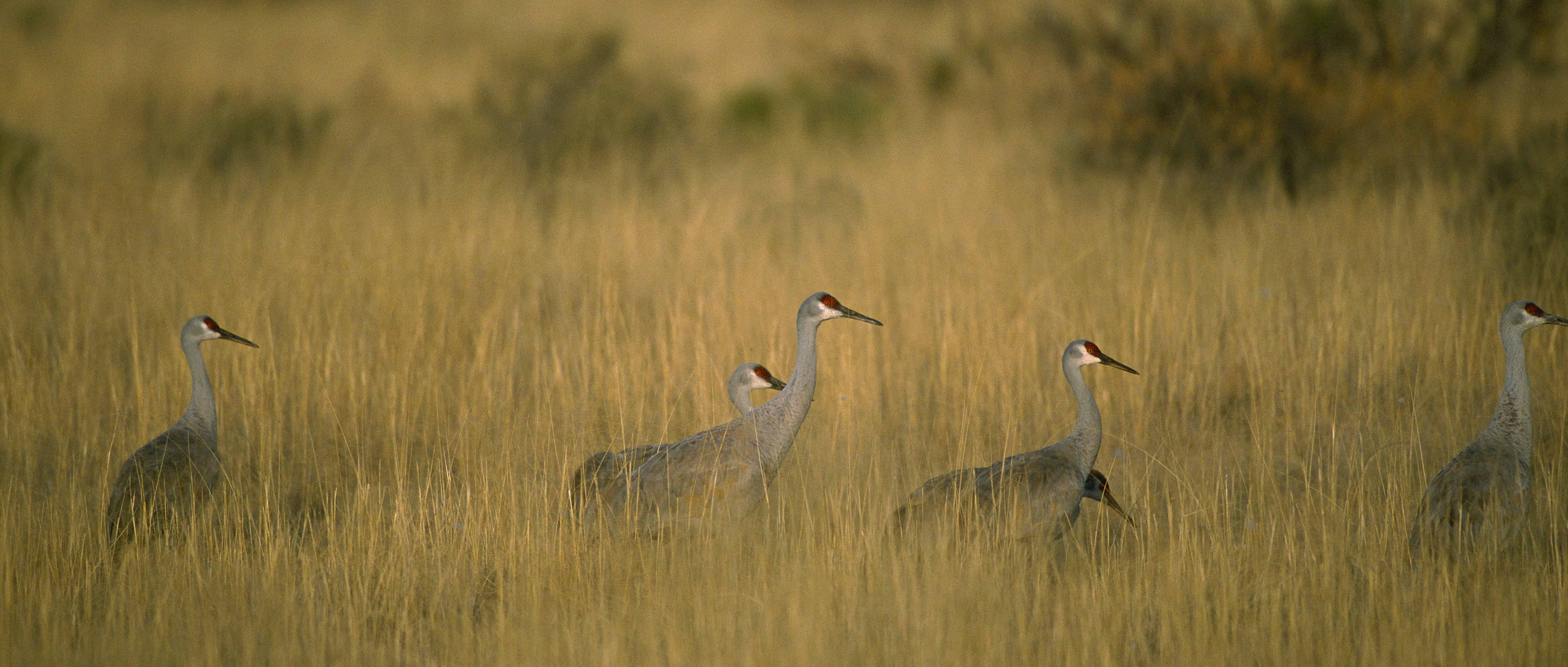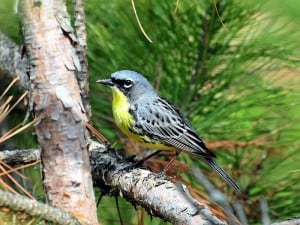Share this article
Resolving Human-Wildlife Conflicts
The Clash between Responsible Management and Perceptions
Many people consider the annual migration of the sandhill crane an unrivaled spectacle of nature. Each year, more than 80 percent of the North American crane population converges on the Platte River in Nebraska. Their stopover in Kearny — the site of Audubon’s Nebraska Crane Festival — has earned the small town the title “Sandhill Crane Capital of the World.” Every year, the arrival of more than half a million birds in March draws thousands of visitors from around the world who are eager to witness this natural phenomenon.
Although the cacophonous crane calls are cause for celebration in Kearny, the birds haven’t always been so popular elsewhere along their southern migration route. In New Mexico’s Rio Grande Valley — where nearly 30,000 sandhill cranes (Grus canadensis) and 50,000 snow geese (Chen caerulescens) spend the winter — farmers used to dread their arrival. Overwintering birds foraged on alfalfa, chili pepper and wheat, often devastating crops. The combination of the two — an iconic bird species and extensive agricultural damage — exemplifies the classic elements that create a human-wildlife conflict.
A look at how wildlife professionals conduct their work when two sides of a conflict seem to be at loggerheads provides insights into how our profession applies integrated management and lethal control within the context of the North American Model of Wildlife Conservation.
The Model
The North American Model of Wildlife Conservation is built upon the premise that wildlife is a public trust resource — owned by no one and managed by the government for the benefit of present and future generations. Although not formally written until 2001, the model has its origins in the 19th century conservation movement and represents the culmination of continually evolving laws and regulations that had been put in place to prevent the over-exploitation of wildlife resources and ways to fund wildlife management.
In addition to the concept of wildlife as a public trust, The Model is built on six other tenets: 1.) elimination of commercial markets for game; 2.) allocation of wildlife by law rather than privilege; 3.) wildlife should be killed only for legitimate purposes; 4.) wildlife is an international resource; 5.) science is the basis for wildlife policy; and 6.) hunting is democratic. These tenets have been widely accepted by wildlife professionals, incorporated into the workings of state wildlife agencies, and endorsed by professional organizations such as The Wildlife Society.
Underlying all six tenets is the idea that lethal take — the killing of wildlife — can be prevented, allowed or even encouraged, provided appropriate regulatory processes are followed that are in line with specific management goals and objectives. Furthermore, local, state and federal agencies work together within that regulatory framework to preserve North American wildlife.
The Evolution of Wildlife Services
Some of the earliest actions taken by the U.S. government to manage wildlife were efforts to prevent and control damage to agricultural crops. In the wake of the first National Biological Survey, Congress authorized the U.S. Department of Agriculture in 1885 to help farmers manage crop damage caused by birds.
Responsibilities of the program soon expanded to include predator control to protect livestock as well as rabies control. Other early priorities centered on agricultural economics and research on methods and tools to help manage wildlife damage issues.
The program remained in the USDA until 1939 when it was transferred to the U.S. Department of the Interior. Then in 1985, it was moved back to the USDA. Over the years, although the program changed names numerous times, its most recognized name was Animal Damage Control. Then in1996, it became Wildlife Services, the name currently in use today. The evolution of Wildlife Services took place within the framework and foundation of the North American Model and focused on protecting the needs of people while recognizing the high value society places on wildlife.
Conflict Resolution in Practice
Resolution of wildlife conflicts relies upon a structured decision model known as integrated wildlife damage management (IWDM). Wildlife Services as well as state and federal agencies and independent professionals resolve wildlife damage issues by applying this model. Not only does employing IWDM help ensure success, but it also helps maintain the profession’s fidelity to the North American Model.

A Wildlife Services technician and partner get ready to release a Kirtland’s warbler after banding it. The project in Wisconsin is a collaborative effort of federal and state agencies and private industry, with strong volunteer support. Image Credit: USFWS, Joel Trick
In most cases, an individual or group reports a wildlife damage conflict that initiates the IWDM process. Wildlife damage management professionals typically start with an assessment that involves identifying the species causing the damage, the affected resources, and the severity of the damage. Solutions can range from technical assistance in which professionals give requestors information on how to resolve the conflict themselves to direct management in which professional IWDM practitioners apply techniques to disperse or remove problem-causing animals.
Management strategies frequently involve sequential application of increasingly aggressive techniques to solve the problem while minimizing the effort, cost and impact to the wildlife species. To ensure successful resolutions of conflicts, IWDM also requires monitoring the application and results.
For example, a homeowner may be concerned about beavers damming a stream. Simply educating the homeowner about beaver ecology and the benefits associated with beaver ponds may put his mind at ease. However, if a homeowner is worried that a beaver might destroy an expensive ornamental tree, the wildlife specialist may recommend installing anti-chewing structures around the tree’s base. Or if a homeowner is tolerant of some flooding but worried that his septic system may be damaged from high water levels, the specialist may suggest the homeowner install a pond-leveling device.
In other situations, more aggressive measures may be needed. For example, a farmer may not tolerate any flooding of a corn field from beaver activity in a nearby stream and request the dam be removed. This strategy may work if the offending animal is a dispersing two-year-old beaver that can be dissuaded from the area by simply removing the dam, but an established colony may continue to rebuild causing further problems. In this case, lethal removal by trapping may be necessary.
When the Stakes Are High
Critics of lethal control frequently argue that public funds should not be used to protect private resources from wildlife damage. But history has shown that in the absence of professional IWDM services, some agricultural producers or resource owners will go to great extents to protect their investments — often with tragic consequences. Indiscriminant use of poisons and lethal bait has killed thousands of non-target animals; however, IWDM programs have proven to be effective at quickly and efficiently removing depredating animals with minimal risk to non-target species. Because the North American Model establishes wildlife as a public resource, government has a legitimate role in resolving wildlife conflicts when they impact private enterprises or human health and safety.
In the case of the Rio Grande Valley sandhill cranes, collaboration between state and federal agencies resulted in a strategy that involves habitat management, harassment and lethal take through regulated public hunting. Portions of nearby wildlife refuges and other management areas are planted with lure crops such as corn to draw birds away from agricultural crops on private lands. To further discourage birds from feeding on commercial crops, a USDA Wildlife Services technician coordinates with the refuge systems and uses pyrotechnics to harass and move birds from farmers’ fields to lure crops at alternate forage sites.
Another part of the strategy to reduce crop damage involves killing offending birds. As hunting season approaches, licensed hunters are encouraged to contact Wildlife Services for information on bird densities and crop damage locations. This coordination allows hunters to remove birds from areas where they are causing damage, while simultaneously reinforcing the non-lethal pyrotechnic methods by preventing cranes and geese from becoming habituated to them.

Wildlife technicians remove cowbirds from a modified Australian crow trap as part of recovery efforts for the endangered Kirtland’s warbler. An average of 200 cowbirds were removed in Wisconsin during each nesting season from 2008-2014, enabling the first successful nesting outside of Michigan in decades. The male Kirtland’s warbler has a distinctive bright yellow breast and song. Image Credit: USFWS, Joel Trick
This integrated management strategy — in place for nearly 20 years now — has dramatically reduced crop damage and enhanced landowner and producer tolerance, while simultaneously enhancing the conservation of these valued wildlife resources throughout their range and in New Mexico’s Rio Grande Valley.
Opposition to Lethal Control
The sandhill crane mitigation effort is just one of many examples of how effective wildlife damage management must take into consideration the many competing values of a diverse public served by the federal and state wildlife agencies entrusted with managing wildlife resources. In some cases, agencies use regulated sport hunting — a form of lethal control — to meet management goals. But in other cases, sport hunting may not be a viable alternative.
Wildlife management agencies sometimes have their own staff conduct lethal measures to protect agriculture, human health and safety, and even other wildlife. These activities fall into three categories: population reduction, such as reducing deer herds to restore forest regeneration; removal of problem individuals, such as eliminating fox preying on nesting piping plover; and reinforcement of hazing to prevent habituation, such as removing birds from airport runways.
Using lethal techniques often draws criticism, with opponents offering a long list of alternatives including birth control, habitat manipulation, exclusion and tolerance. In truth, all are important tools in an IWDM approach. However, the loss of lethal management as a technique available to wildlife agencies would not only jeopardize resolution of wildlife conflicts, but also the survival of some species.
Take, for example, the story of the Kirtland’s warbler (Setophaga kirtlandii), a bird that was nearly extinct 50 years ago. Its long road to recovery and some of the choices made to secure its recovery also illustrate the necessity of lethal control methods.
This endangered warbler requires dense young stands of fire-dependent Jack pine (Pinus banksiana) for nesting. However, fire suppression had severely restricted available nesting habitat leaving only isolated patches in the Lower Peninsula of Michigan. Extensive habitat management conducted by a broad partnership of federal, state and private groups improved habitat conditions in Michigan as well as in Wisconsin and Canada. However, the birds failed to recolonize these habitats because their nests were being parasitized by brown-headed cowbirds (Molothrus ater). At the request of the U.S. Fish and Wildlife Service and Wisconsin Department of Natural Resources, Wildlife Services initiated a cowbird trapping program in Wisconsin in 2008. That spring, the endangered Kirtland’s warbler successfully nested outside of Michigan for the first time in more than 40 years. Last year, seven breeding pairs in Wisconsin successfully fledged eight to 10 young — an unlikely accomplishment without the continued lethal removal of brown-headed cowbirds. A similar trapping program began in 1972 in Michigan and by 2002 Kirtland warbler fledging rates had increased from less than one to nearly three birds per nest.
Finding Acceptable Resolutions
Although the wildlife profession has long recognized the legitimacy of lethal control when practiced ethically within a science-based management strategy, the practice continues to draw strong public opposition and, in some instances, disagreements within the wildlife profession.
Some stakeholders view the killing of any animals as unnecessary and harmful not only to wildlife but to society. The changing demographics of U.S. citizens and their increasing dissociation from the natural world has created a knowledge gap in which misinformation can be used to generate widespread opposition from far beyond the areas affected by a conflict.
Exacerbating these situations is the modern social media movement, which facilitates instantaneous dissemination of unvetted information and opinions designed to sway public opinion. As a result, wildlife managers often find themselves balancing the needs of directly impacted stakeholders with those of far-removed wildlife enthusiasts.
![]() Professional organizations such as The Wildlife Society have long supported lethal take. TWS’s Standing Position Statement on the North American Model of Wildlife Conservation states, “Prevention or control of wildlife damage, which often includes removal of the animals responsible for the damage, is an essential and responsible part of wildlife management.”
Professional organizations such as The Wildlife Society have long supported lethal take. TWS’s Standing Position Statement on the North American Model of Wildlife Conservation states, “Prevention or control of wildlife damage, which often includes removal of the animals responsible for the damage, is an essential and responsible part of wildlife management.”
This is not to say that the wildlife community itself is unified in its acceptance of lethal control. A healthy debate is ongoing, which will be examined in-depth in the symposium, “Wildlife Conservation’s Dilemma: Fur, Feather, Fins, Steel and People,” at The Wildlife Society’s 22nd Annual Conference to be held in October in Winnipeg. Several TWS Working Groups will participate in the discussion including: Hunting, Trapping and Conservation; Human Dimensions; Wildlife Damage Management; and Public Conservation, Education and Extension.
Wildlife Services staff will participate in the symposium. Our hope is that this gathering will lead to a renewed commitment to improve communications within and outside the wildlife profession regarding the importance of lethal take as a tool to manage wildlife conflict issues within the context of the North American Model of Wildlife Conservation.
Header Image: Sandhill cranes graze in a decoy crop at a New Mexico wildlife refuge used to draw them away from agricultural fields. During the regular hunting season, wildlife officials direct private hunters to locations where birds and damage are heaviest. Integrated damage management using dispersal techniques, lure crops, and public hunting has improved farmers’ tolerance for the overwintering birds.
Image Credit: USFWS









